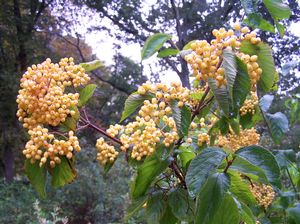View All Plants :: View All DECIDUOUS SHRUBS
Viburnum dilatatum 'Michael Dodge'
Linden Viburnum
Plant Type:
DECIDUOUS SHRUBSViburnum dilatatum ‘Michael Dodge’ – Bearing large, light yellow fruit clusters in contrast to the all other V. dilatatum selections which display red berries 'Michael Dodge' is exceptional. When the yellow fruit is set against the russet orange fall color it is not only fall, it is quintessential autumn! It's downright rutilant! Okay, okay - I had no clue this word even existed until a friend of ours, Deborah B. ran across it and delightedly shared her new-found vocabulary stumper with us. In winter we have seen chickadees, cardinals and titmice, white-throated, song and chipping sparrows devouring the fruits when food has become scarce; it may be that the berries become more palatable after bletting. Plant it in near proximity to 'Erie' or another V. dilatatum selection or V. erosum for its copious late season berries. In any scenario 'Michael Dodge' is an important element in our winter garden... Viburnum dilatatum 'Erie', too. The species is from Eastern Asia. 'Michael Dodge' is of garden origin - and a beauty at that. This came to from Michael Dodge, the creator of this wonderful Viburnum, “Hello I noticed you list my Viburnum dilatatum 'Michael Dodge'. FYI: this was a deliberate cross I made at Winterthur Gardens in Delaware while working there. I took the pollen of a good selection of V. dilatatum and pollenated V. dilatatum 'Xanthocarpum' - a small fruited yellow cultivar. The resulting seeds / seedlings produced red / orange fruit and Winterthur selected the best and named it after me as I was the progenitor! The rest were sold to local nurserymen I believe.”
Characteristics and Attributes for Viburnum dilatatum 'Michael Dodge'
Season of Interest (Flowering)
- Spring
Season of Interest (Foliage)
- Spring / Summer / Autumn
Autumn Interest
- Fruit / Berries / Seed Heads
- Autumn Leaf Color
Nature Attraction
- Songbirds
- Deer Resistant
- Honey Bees & Native Bees
Light
- Full Sun
- Mostly Sunny
Attributes
- Specimen
- Wildlife Garden
- Shrub Border
- Hedge
- Hedgerow
Growth Rate in the Garden
- Medium
Soil
- Fertile
Propagated By
- Cutting Grown
Genus Overview: Viburnum
Common Name: Viburnum
Viburnum. This genus is full of fantastic, multi-season garden worthy shrubs. Garden heroes. Spring flowers, often large and showy, many with heady sweet fragrance are arranged in cymes. Some smell of musk (Viburnum dilatatum) while others produce no fragrance at all. Flowers are followed with berries. If late season and autumn berries are desired then planting two of a species will ensure fruit set; for instance, Viburnum dilatatum 'Erie' and V. dilatatum 'Michael Dodge' will pollinate each other and produce fruit. Viburnum cassinoides is closely allied with V. nudum; but if the flowering times do not overlap then there will be no fruit. However, if you plant V. nudum 'Winterthur' in proximity with V. nudum var. angustifolium, 'Longwood', 'Moonshine' or 'Pink Beauty' berries will abound. Another interesting example is V. lantana which crosses with V. burejaeticum and vice versa. Any V. plicatum f. tomentosum selection such as 'Shasta' or 'Shoshoni' will pollinate with all other V. plicatum f. tomentosum selections like 'Copper Ridges or 'Pink Beauty'. But if you were to plant two 'Shasta' side by side with no other V. plicatum f. tomentosum in near proximity then your effort will be fruitless. As with almost all in the universe of plants there are exceptions. There is one viburnum which appears to be self-fruitful, Viburnum setigerum the Tea Viburnum. Another interesting exception to the rule is Viburnum nudum 'Pink Beauty' which is also self-fruitful - a departure from its siblings. And on the other spectrum are two I can think of off-hand that are barren, Viburnum plicatum 'Roseum' and Viburnum plicatum 'Kern's Pink'. Oftentimes, the dwarf viburnums reamin in a juvenile state and do not produce fruit. All Viburnum of any size that do produce fruit are magnificent in the late season garden. And they feed all manner of birds. Larger, denser shrubs provide cover and nesting opportunities. Nearly all Viburnum have terrific autumn foliage colors, too. Viburnums are members of Caprifoliaceae. All prefer part to full sun and fertile soils. All are cutting grown. Many thanks to Gary Ladman of Classic Viburnums who generously set us straight regarding some of the details we had originally incorrectly lauded... ya can't know everything!


